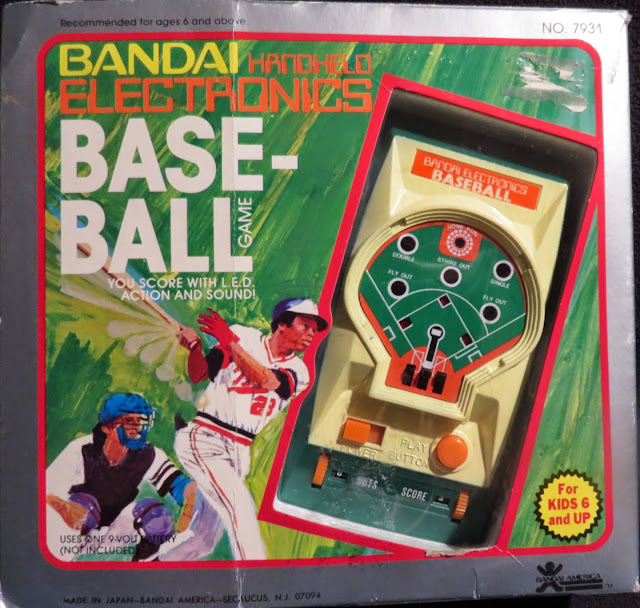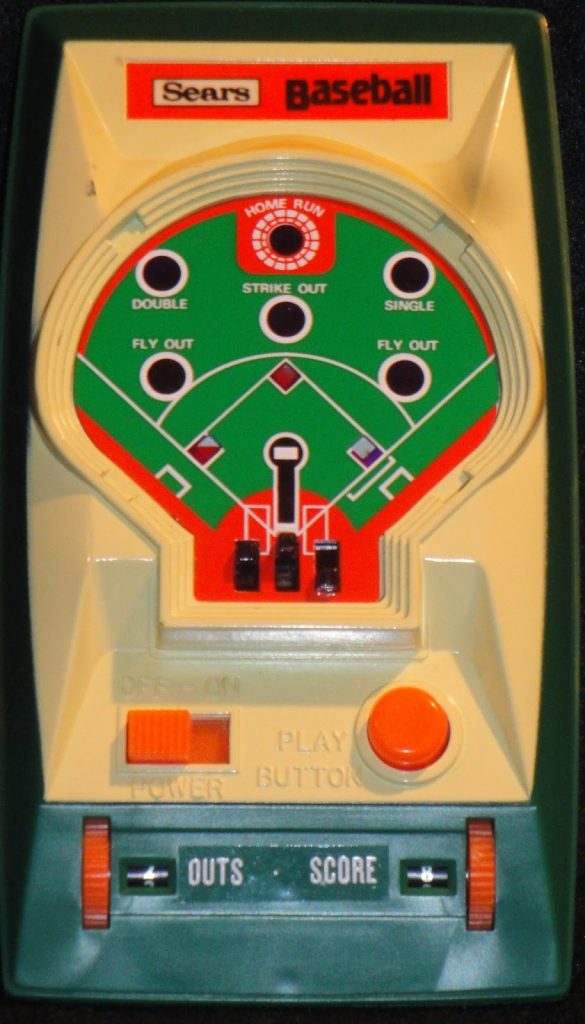Twins first baseman Rod Carew put together a season for the ages in 1977 as he led the American League in runs (128), hits (239), triples (16), batting average (.388), on-base percentage (.449) and intentional walks (15)—all career high marks. Carew also set or tied career highs in doubles (38), home runs (14), runs batted in (100) and bWAR (9.7). He was the runaway MVP selection.
The July 5, 1977 issue of Sports Illustrated included this iconic shot of Carew taken by Tony Triolo.

An illustrated version of that photograph appeared on the box for Bandai Electronics cleverly titled Baseball Game released in 1978, a game that would not remotely approach the excitement Rod Carew provided to baseball fans in Minnesota and beyond.
The game is very rudimentary and there is no strategy or skill component. All the player does is press the button to stop the flashing light on the particular play outcome (and you can’t even hit a triple). The player is then responsible for keeping track of outs and runs manually. How fun!
In late 1979, the demand for handheld electronic games caused a worldwide chip shortage such that retailers, such as Service Merchandise, were only being allocated 10 percent of the games they had ordered. The soaring popularity of these games also led Consumer Reports to test several for “enjoyment and performance.” Not surprisingly, Bandai Baseball scored low marks, with the publication noting the game “presented no challenge to skill or strategy,” especially when compared to games manufactured by Mattel and Fonas.
The advertised prices for the Bandai game were typically in the $7 to $10 range (approximately $30 to $40 USD today) and a least a third of the retail prices for the other handheld electronic baseball games on the market at the time. Whether due to the chip shortage or bargain price, it seems likely that children across North America were likely disappointed receiving the Bandai game as a holiday gift. Today, the game offers little entertainment value.
There are currently four known variations of the game to exist, two sold by Bandai and two licensed and sold by Sears. All versions are powered by a single 9-volt battery.
1. Bandai – Baseball Game / Model No.: 7931
-

Bandai Version 1 – Box Front -

Bandai Version 1 – Box Back -

Bandai Version 1 – Game Front -

Bandai Version 1 – Game Bottom
The initial version of the Bandai Baseball game did include any mechanism to keep track of the runners on base. and was sold in a larger square-shaped box. Simple instructions are listed on a sticker found on the underside of the game.
2. Bandai – Baseball Game / Model No.: 7931
-

Bandai Version 2 – Box front -

Bandai Version 2 – Box back -

Bandai Version 2 – Game front -

Bandai Version 2 – Game back
The redesigned version of the game added plastic sliders to keep track of runners on base. This second version was packaged in a smaller box with a flap, with front graphics that looked similar to the initial version. The game was identified with the same model number, Bandai apparently deciding not to rename the improved version (e.g., “Baseball 2”).
3. Sears – Baseball Game (Canadian Version) / Model No.: 917931
-

Sears Canadian Version – Box front -

Sears Canadian Version – Box back -

Sears Canadian Version – Game front -

Sears Canadian Version – Game back
Sears licensed this game from Bandai and the Bandai logo is molded into the plastic on the underside of the game. A company named Leisure Dynamics of Canada is also listed on the back of the box but it is not clear what the company’s role was in getting the game to market. (This box also featured the Rod Carew illustration, who hit .432 against the expansion Toronto Blue Jays in their 1977 debut season.)
The game itself is slightly different than the one pictured on the back of the box in that the sticker at the top of the actual game identifies Sears more clearly and the path that leads from the pitcher’s mound to home plate is black, not orange, on the actual game.
Bilingual instructions are found on the bottom of the game.
4. Sears – Electronic Baseball / Model No.: 49-65278
-

Sears U.S. Version – Box -

Sears U.S. Version – Game front -

U.S. Version – Game back
Like the Canadian version, the Bandai logo is imprinted on the underside of the game. The game, itself differs slightly than the one pictured on the box. The top sticker has different colors and font, the playing surface uses a different font and the path from the pitcher’s mound to home plate is colored differently.
It is not immediately clear what the shivering robot on the box has to do with baseball. This game was still being sold as late as the 1980 Sears Christmas Wishbook.
Sources:
www.baseball-reference.com
Sports Illustrated, July 5, 1977.
Advertisement, Daily News (Lebanon, Pennsylvania), August 30, 1979: 39.
Larry Werner, “Electronic toys are troublesome to find,” Tampa Times, December 11, 1979: 8. Sears Christmas Wishbook, 1980: 664.
John is a Chicago lawyer with an insatiable interest in baseball-related litigation. When not rooting for his beloved Cubs (or working), he is probably reading a baseball book or blog, planning his next baseball trip, or enjoying downtime with his wife and family. He is probably the world’s foremost photographer of triple peanuts found at ballgames and likes to think he has one of the most complete collections of vintage handheld electronic baseball games known to exist. John is a member of the Emil Rothe (Chicago) SABR Chapter and Co-Chair of the SABR Baseball Landmarks Research Committee.
- John Racanellihttps://sabrbaseballgaming.com/author/john-racanelli/

